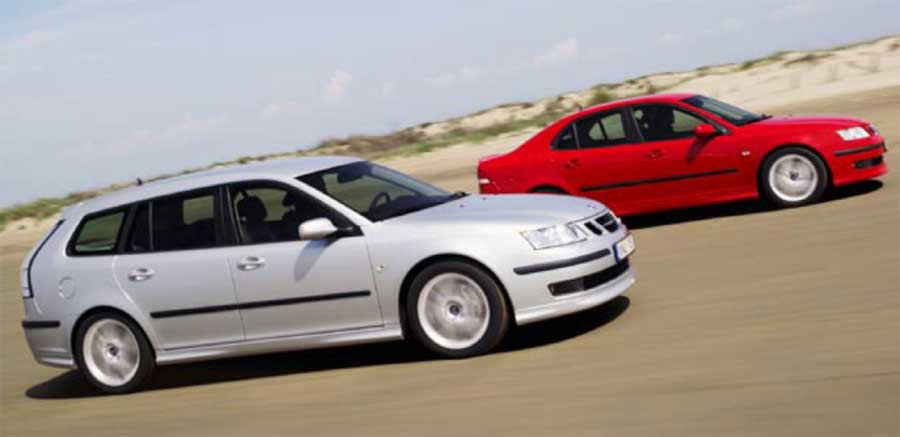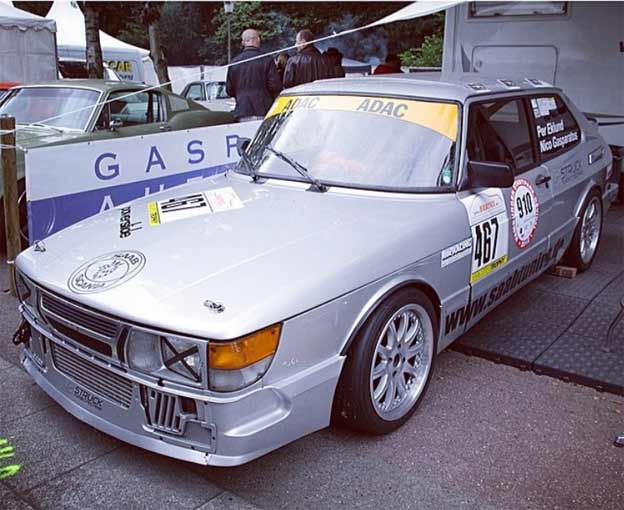Now, in 2021, we are counting an entire decade since there were no new Saab cars, but that doesn’t mean we can’t remember how it used to be at the premieres of the new models. This time we remember one of the first road tests of the then new Saab 9-3 Sportcombi model done by the famous Australian car journalist Tim Britten.
Table of Contents
Turbocharged V6 brawn makes Saab’s SportCombi a tearaway wagon
SAAB really needed a wagon version of the 9-3. When the company ditched the hatchback design that was such a handy feature of the previous model in favour of a conventional four-door sedan, it left a practicality gap filled only by the larger 9-5 Estate.
Saab never really liked to admit it – because the conception is that prestige buyers tend to prefer sedans over hatchbacks – but the previous 9-3’s five-door configuration was actually one of its best features. For a mid-size car, it could swallow some surprisingly bulky luggage when the back seat was folded.
Once Saab got the sedan 9-3 it wanted, that versatility disappeared, even though the current model does feature a split-fold rear seat and rates pretty well, in cargo-carrying terms, for a sedan. But first, let’s look at the SportCombi wagon’s credentials.

fractionally slower than 9-3 Aero sedan.
Dimensionally close to the 9-3 sedan in all dimensions except height and length – and then it’s bigger by only by a few centimetres – the SportCombi is a true Euro wagon in terms of the way everything functions although it lacks some of the little surprises you might find in, say, a Volvo. The cargo area is pretty straightforward, with a lift-up carpeted floor panel that reveals a shallow second floor and – after unscrewing two bolts – the full-size steel spare that provides space in its deeply-dished centre for the Prestige 300 sound system’s 10-inch sub woofer. The gun sound system is standard in the Aero SportCombi and replaces the more mundane sevenspeaker system used in the Linear version.
The space provided is pretty useable – although the gap between the rear suspension struts tends to be a little tight – and is accessed via a big, light aluminium tailgate. With the seats in place, the SportCombi gives you a cargo area of 419 litres, expanding to 1273 litres with the seats folded. A good thing is that folding the rear seat is a simple, single motion forming a dead-flat floor. As you’d expect, a heavy-duty cargo blind is part of the deal, although you’ll have to pay extra for security nets to protect the passenger area from flying cargo.
But the SportCombi passes the fully-assembled mountain bike test without a problem – and offers an optional dedicated roof rack for those who want to carry their bikes while leaving the interior clear. As for the rest of the passenger compartment, it’s all pretty much the same as a 9-3 Aero sedan. The leather-trimmed power front seats (with three-way memory on the driver’s side) are a little shapelier than your regular 9-3 and provide levels of support only really appreciated after a few hours at the wheel.
In the back it’s all quite tight if there’s anyone more than 180 centimetres tall riding up front, which somewhat compromises the SportCombi’s utility. For the driver, there’s a nicely presented array of controls bearing the distinctive Saab design stamp. The panel shape itself is reminiscent of the previous 9-3 and you’ll find some Saab features such as the night panel lighting and the asymmetric speedometer readout introduced by the company some time ago and now appearing on a few other brands.
Feeling like in an airplane cockpit
The Aero steering wheel, with its somewhat downmarket silver plastic inserts, inbuilt (on auto versions) sequential automatic shift buttons and radio controls, is surprisingly large but at least it can be adjusted for height and reach. Controls for the on-board computer aren’t quite intuitive, but don’t require a PhD to operate and there’s a climate-control air-conditioning system with separate controls for driver and front passenger.
And, in pride of place on the centre console, is Saab’s signature central ignition switch. Seen in some circles as a gimmick, in practice it actually works very well (if you really want to talk gimmicks, then take a look at the proliferating starter buttons finding their way into more and more new models). Not so handy is the disguised-as-grabhandle handbrake, which can all too easily graze an errant finger in the small gap between the end of the lever and the console extension if it’s released without due attention. On the road, the SportCombi Aero is something of a mixed bag.
Great Performance
Fine, the 2.8-litre turbo V6 may be the most powerful Saab engine yet, and it may deliver the quickest-accelerating Saab, but somehow the six-speed auto version doesn’t feel as eager and ready to pounce as you might expect. In fact the V6 needs a little coaxing before those Newton metres begin to make themselves felt. A gentle prod off the line will produce only leisurely acceleration.
Give the Aero a bootful and it will scramble off the mark with not a little interference from the traction control system as it seeks to maintain dignity, in the end delivering a sort all-ornothing aspect to the acceleration. Which is something the Aero does well, even in auto form, where the official figures tell us it will reach 100km/h in 7.8 seconds (The manual SportCombi is a lot better though, reaching 100km/h in 6.9 seconds, only .2 of a second behind the equivalent Aero sedan).
On the move, the Sentronic six-speed auto shifts smoothly and mostly unnoticeably, with the sequential function available either via the steering wheel buttons or the more practical shift lever, which drops a ratio by snicking it backwards and up-shifts by pushing forward. The Aero points very nicely, not as hampered by the largish steering wheel as first anticipated.
It goes like on rails
The test car was fitted with the optional 18-inch wheels, which obviously added to steering precision but also contributed to a ride that already, with more aggressive spring and damper settings, tends towards harshness, particularly over smaller, sharp-edged bumps.
This didn’t help the car’s ability to hold steadfastly to a chosen line if the road was even a little rough and made the business of driving quickly less of a sporting pleasure than the Aero tag indicates. The Aero trends to skitter rather than grip if there’s a bump or two on the way through a corner. It puts the Aero’s upgraded ESP Plus stability control system (it is programmed for more for enthusiastic drivers and builds-in brake-fade compensation) to the test.
The harshness also tested the integrity of the open wagon structure, and the security of the internal fittings to the point that the SportCombi produced a few squeaks and rattles that were at first disconcerting and in the end downright annoying. We don’t have any worry about the Saab’s structural safety, but would have preferred a cushier, quieter, more prestigious experience on the road. One thing we didn’t mind was the deep, sonorous note produced by the Holden-built engine’s dual exhaust system.
V6 Saab
There is never a stage in the performance scale where you’re not aware this is a V6 Saab. Like we said, the Saab Aero SportCombi is something of a mixed bag, in which rummaging around will reveal pleasant surprises and unexpected disappointments in equal proportions.
The suspicion is that the regular 17-inch wheels would soften and improve the ride, while making the general handling more acceptable on anything but perfectly smooth hotmix. Here, the optional fat wheeltyre combination would unarguably produce better ultimate grip. As far as equipment goes, there’s not a lot that can be added to the Aero SportCombi apart from a sunroof, bi-Xenon headlights, roof rack and an inbuilt telephone system.
Safety First
The airbag pack is pretty standard for a prestige Euro car today, with adaptive, dual front airbags, seatmounted side bags and full-length curtain airbags. Anti-whiplash front seats are standard.
Check out the base 1.8t SportCombi – which is pretty well equipped anyway with leather seats and steering wheel, heated front seats, climate-control, glovebox cooler, heated exterior mirrors, rain-sensing wipers, remote-opening front windows and a seven-speaker “Premium” sound system – before you lay down the extra $27,000 needed to step up to the Aero (and $27,400 more for the six-speed auto).












